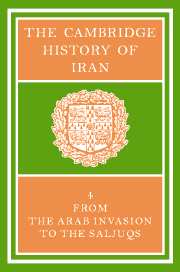Book contents
- Frontmatter
- 1 THE ARAB CONQUEST OF IRAN AND ITS AFTERMATH
- 2 THE ‘ABBĀSID CALIPHATE IN IRAN
- 3 THE ṬĀHIRIDS AND ṢAFFĀRIDS
- 4 The SĀMĀNIDS
- 5 THE EARLY GHAZNAVIDS
- 6 THE MINOR DYNASTIES OF NORTHERN IRAN
- 7 IRAN UNDER THE BŪYIDS
- 8 TRIBES, CITIES AND SOCIAL ORGANIZATION
- 9 THE VISUAL ARTS
- 10 NUMISMATICS
- 11 THE EXACT SCIENCES
- 12 LIFE SCIENCES, ALCHEMY AND MEDICINE
- 13(a) PHILOSOPHY AND COSMOLOGY
- (b) SŪFISM
- 14 THE RELIGIOUS SCIENCES
- 15 SECTS AND HERESIES
- 16 NĀSIR-I KHUSRAU AND IRANIAN ISMĀ‘ĪLĪSM
- 17 ZOROASTRIAN LITERATURE AFTER THE MUSLIM CONQUEST
- 18 ARABIC LITERATURE IN IRAN
- 19 THE RISE OF THE NEW PERSIAN LANGUAGE
- 20 (a) THE “RUBĀ'Ī” IN EARLY PERSIAN LITERATURE
- (b) ‘UMAR KHAYYĀM: ASTRONOMER, MATHEMATICIAN AND POET
- Bibliography
- Index
- Plate section
- Plate section">
- Map 1. Iran under the Abbasids">
- References
5 - THE EARLY GHAZNAVIDS
Published online by Cambridge University Press: 28 March 2008
- Frontmatter
- 1 THE ARAB CONQUEST OF IRAN AND ITS AFTERMATH
- 2 THE ‘ABBĀSID CALIPHATE IN IRAN
- 3 THE ṬĀHIRIDS AND ṢAFFĀRIDS
- 4 The SĀMĀNIDS
- 5 THE EARLY GHAZNAVIDS
- 6 THE MINOR DYNASTIES OF NORTHERN IRAN
- 7 IRAN UNDER THE BŪYIDS
- 8 TRIBES, CITIES AND SOCIAL ORGANIZATION
- 9 THE VISUAL ARTS
- 10 NUMISMATICS
- 11 THE EXACT SCIENCES
- 12 LIFE SCIENCES, ALCHEMY AND MEDICINE
- 13(a) PHILOSOPHY AND COSMOLOGY
- (b) SŪFISM
- 14 THE RELIGIOUS SCIENCES
- 15 SECTS AND HERESIES
- 16 NĀSIR-I KHUSRAU AND IRANIAN ISMĀ‘ĪLĪSM
- 17 ZOROASTRIAN LITERATURE AFTER THE MUSLIM CONQUEST
- 18 ARABIC LITERATURE IN IRAN
- 19 THE RISE OF THE NEW PERSIAN LANGUAGE
- 20 (a) THE “RUBĀ'Ī” IN EARLY PERSIAN LITERATURE
- (b) ‘UMAR KHAYYĀM: ASTRONOMER, MATHEMATICIAN AND POET
- Bibliography
- Index
- Plate section
- Plate section">
- Map 1. Iran under the Abbasids">
- References
Summary
The establishment of the Ghaznavid sultanate in the eastern Iranian world represents the first major breakthrough of Turkish power there against the indigenous dynasties. The peaceful penetration of Turks into the originally Iranian lands of Central Asia, sc. into Transoxiana, Farghāna and Khwārazm, and across the Dihistān Steppe (the modern Qara Qum Desert) towards the Caspian coastlands, had, however, begun several centuries before. The Iranian rulers of Soghdia who opposed the Arab invaders of the 1st/7th and early 2nd/8th centuries received assistance from the Western Turks, before the steppe empire of these Türgesh itself disintegrated. In addition to this, the Soghdian princes hired Turks from the steppes as mercenary soldiers and as frontier guards, thus anticipating the ‘Abbāsid caliphs’ employment of Turkish slaves in their armies. In what was, before the rise of the Sāmānids, a politically fragmented region, with the independent political unit often little more than the city-state or petty principality, there was frequent internecine warfare and consequent employment for these warriors.
The Sāmānid amirate in Transoxiana and Khurāsān meant that there was a strong barrier in the northeast against mass incursions from the steppes into the civilized zone. The Iranian world was now protected by a vigorous power, whose central government in Bukhārā had an advanced bureaucracy, utilizing techniques evolved in the 'Abbāsid caliphate, and a well-disciplined professional army. Again, this army followed the ‘Abbāsid pattern in that it had a core of Turkish slave guards (ghilwān, mamālīk) personally attached to the amīr. Hence during the heyday of the Sāmānids – up to the middle of the 4th/10th century – the frontiers of Transoxiana were held firm against pressure from the Turks outside.
- Type
- Chapter
- Information
- The Cambridge History of Iran , pp. 162 - 197Publisher: Cambridge University PressPrint publication year: 1975
References
- 9
- Cited by



